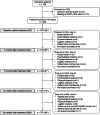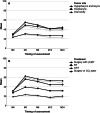The course of swallowing problems in the first 2 years after diagnosis of head and neck cancer
- PMID: 36040669
- PMCID: PMC9633522
- DOI: 10.1007/s00520-022-07322-w
The course of swallowing problems in the first 2 years after diagnosis of head and neck cancer
Erratum in
-
Correction to: The course of swallowing problems in the first 2 years after diagnosis of head and neck cancer.Support Care Cancer. 2022 Nov;30(11):9539-9540. doi: 10.1007/s00520-022-07355-1. Support Care Cancer. 2022. PMID: 36085423 Free PMC article. No abstract available.
Abstract
Introduction: Head and neck cancer (HNC) and its treatment often negatively impact swallowing function. The aim was to investigate the course of patient-reported swallowing problems from diagnosis to 3, 6, 12, and 24 months after treatment, in relation to demographic, clinical, and lifestyle factors.
Methods: Data were used of the Netherlands Quality of Life and Biomedical Cohort Study in head and neck cancer research (NET-QUBIC). The primary outcome measures were the subscales of the Swallowing Quality of Life Questionnaire (SWAL-QOL). Linear mixed-effects models (LMM) were conducted to investigate changes over time and associations with patient, clinical, and lifestyle parameters as assessed at baseline.
Results: Data were available of 603 patients. There was a significant change over time on all subscales. Before treatment, 53% of patients reported swallowing problems. This number increased to 70% at M3 and decreased to 59% at M6, 50% at M12, and 48% at M24. Swallowing problems (i.e., longer eating duration) were more pronounced in the case of female, current smoking, weight loss prior to treatment, and stage III or IV tumor, and were more prevalent at 3 to 6 months after treatment. Especially patients with an oropharynx and oral cavity tumor, and patients receiving (C)RT following surgery or CRT only showed a longer eating duration after treatment, which did not return to baseline levels.
Conclusion: Half of the patients with HNC report swallowing problems before treatment. Eating duration was associated with sex, smoking, weight loss, tumor site and stage, and treatment modality, and was more pronounced 3 to 6 months after treatment.
Keywords: Head and neck cancer; Linear mixed-effects model; Oral function; SWAL-QOL; Swallowing.
© 2022. The Author(s).
Conflict of interest statement
The authors declare no competing interests.
Figures



Similar articles
-
Prevalence of swallowing and speech problems in daily life after chemoradiation for head and neck cancer based on cut-off scores of the patient-reported outcome measures SWAL-QOL and SHI.Eur Arch Otorhinolaryngol. 2016 Jul;273(7):1849-55. doi: 10.1007/s00405-015-3680-z. Epub 2015 Jun 14. Eur Arch Otorhinolaryngol. 2016. PMID: 26071622 Free PMC article.
-
Prospective clinical study on long-term swallowing function and voice quality in advanced head and neck cancer patients treated with concurrent chemoradiotherapy and preventive swallowing exercises.Eur Arch Otorhinolaryngol. 2015 Nov;272(11):3521-31. doi: 10.1007/s00405-014-3379-6. Epub 2014 Nov 8. Eur Arch Otorhinolaryngol. 2015. PMID: 25381096 Clinical Trial.
-
Factors associated with swallowing dysfunction in patients with head and neck cancer.Oral Dis. 2023 Jul;29(5):1937-1946. doi: 10.1111/odi.14192. Epub 2022 Mar 27. Oral Dis. 2023. PMID: 35298058
-
Nutrition impact symptoms and associated outcomes in post-chemoradiotherapy head and neck cancer survivors: a systematic review.J Cancer Surviv. 2018 Aug;12(4):479-494. doi: 10.1007/s11764-018-0687-7. Epub 2018 Mar 20. J Cancer Surviv. 2018. PMID: 29556926
-
Changes in Swallowing-related Quality of Life After Endoscopic Treatment For Zenker's Diverticulum Using SWAL-QOL Questionnaire.Dysphagia. 2017 Jun;32(3):339-344. doi: 10.1007/s00455-017-9782-6. Epub 2017 Mar 9. Dysphagia. 2017. PMID: 28275907 Review.
Cited by
-
Factors influencing physical activity in individuals with head and neck cancer: a scoping review.BMJ Open. 2024 Jul 17;14(7):e083852. doi: 10.1136/bmjopen-2023-083852. BMJ Open. 2024. PMID: 39019637 Free PMC article.
-
The Change in Social Eating over Time in People with Head and Neck Cancer Treated with Primary (Chemo)Radiotherapy: The Role of Swallowing, Oral Function, and Nutritional Status.Cancers (Basel). 2023 Mar 4;15(5):1603. doi: 10.3390/cancers15051603. Cancers (Basel). 2023. PMID: 36900393 Free PMC article.
-
Improved quality of life in head and neck cancer patients treated with modern arc radiotherapy techniques - A prospective longitudinal analysis.Front Oncol. 2024 Sep 23;14:1424034. doi: 10.3389/fonc.2024.1424034. eCollection 2024. Front Oncol. 2024. PMID: 39376987 Free PMC article.
-
Swallowing after Oral Oncological Treatment: A Five-Year Prospective Study.Cancers (Basel). 2023 Sep 1;15(17):4371. doi: 10.3390/cancers15174371. Cancers (Basel). 2023. PMID: 37686646 Free PMC article.
-
Return to Work Up to 5 Years After the End of Treatment Among Patients With Head and Neck Cancer.JAMA Otolaryngol Head Neck Surg. 2025 Apr 1;151(4):297-310. doi: 10.1001/jamaoto.2024.4991. JAMA Otolaryngol Head Neck Surg. 2025. PMID: 39913126
References
MeSH terms
LinkOut - more resources
Full Text Sources
Medical
Research Materials

